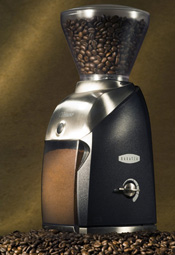

The earliest coffee drinkers broke up their coffee beans with a mortar and pestle, but very early in its history coffee began to be ground between the same millstones that the early peoples of the Middle East used to reduce grain to flour. Later, the Turkish-style coffee grinder evolved, a portable, specialized device similar in size and function to the contemporary pepper mill. Small, corrugated metal plates replaced the large mill stones, creating a grinder technology that has never been improved upon. Many variations have been developed, including hitching the plates to an electric motor, but the principle remains the same.
All burr grinders, regardless of size and price, work approximately the same way. A receptacle at the top of the grinder stores a supply of beans. When you activate a timer, beans feed automatically, a few at a time, through the burrs, which spray the ground coffee into a removable receptacle at the bottom front of the appliance. The timer shuts the grinder off automatically. These machines produce a more consistent grind than the cheaper electric blade grinders, they usually do not have to be fussed over while they grind, and they definitely do not need to be cranked by hand. You must be prepared, however, to clean the aperture for the ground coffee after every third or fourth use (some coffee stores sell a brush for this purpose; a small, stiff paintbrush works fine), and periodically open the grinder and clean the burrs. If you grind oily dark roasts, you may find that a brush is not enough for cleaning your grinder; you may have to literally carve the caked coffee from parts of your grinder when you carry out a major cleaning. Finally, burr grinders cannot be used successfully with flavored coffees. The flavoring liquids absorbed in the beans both gum up the burrs and taint subsequent batches of non-flavored coffees.
The heart of the grinder consists of either two little corrugated metal disks, or a corrugated metal cone that fits inside a second, hollow corrugated cone. One element is stationary and the other is rotated by a handle or motor. The coffee is fed, a bean or two at a time, between the corrugated disks, where it is crushed until it drops out of the bottom of the grinder. This solution has never been improved upon because the grind is uniform, and adjusting the space between the plates regulates the fineness of the grind accurately and consistently.
Information Source: Coffee Review and Image Source: Caffe Vita
Grinding
Blade Grinder | Types of Grinds | Grinding Overview
Java
Drip Brew | French Press | Percolator | Vac Pot | Chemex
Turkish | Pour-Over | Instant | Espresso | Water Quality | Java Overview

















































